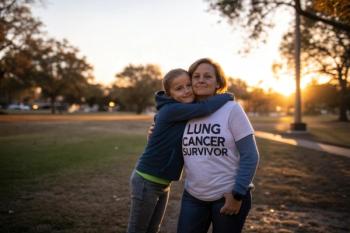
Exploring the Relationship Between Immunotherapy and Body Composition in Advanced NSCLC
Researchers evaluated the association between body composition from readouts generated by cross-sectional imaging and oncologic outcomes in patients with advanced or metastatic NSCLC treated with systemic immunotherapy.
Evidence supporting the degree to which skeletal muscle mass and adipose tissue loss are predictors of poor outcomes in patients undergoing systemic therapy for advanced non-small cell lung cancer (NSCLC) was recently published in JAMA Oncology.
Researchers evaluated the association between body composition from readouts generated by cross-sectional imaging and oncologic outcomes in patients with advanced or metastatic NSCLC treated with systemic immunotherapy.
Hugo Aerts, Ph.D., director of Artificial Intelligence in Medicine at Harvard-Mass General Brigham and his research team identified a correlation between changes in subcutaneous adipose tissue density and prognosis in female patients treated with immune checkpoint inhibitors.
The team also found that male patients who experienced loss of skeletal muscle during systemic therapy for NSCLC may be indicative of poor health outcomes.
Advanced NSCLC is a challenging disease to treat, with high mortality rates and limited treatment options. Immunotherapy has emerged as a promising treatment for this most common type of lung cancer.
However, body composition as a potential prognostic marker plays a vital role in overall health and quality of life for cancer patients and a better understanding of this biomarker may help inform treatment decisions.
Body composition refers to the proportion of fat, muscle, and bone in the body. Changes in body composition, such as muscle loss or increased fat mass, can have significant implications for cancer patients, affecting their overall health, quality of life and treatment outcomes.
The JAMA study population consisted of retrospective Dana-Farber Brigham Cancer Center (DFBCC) cohorts and prospective immunotherapy clinical trial data sets including the MYSTIC trial. Body composition profiling at baseline and follow-up scans included measurements of subcutaneous adipose tissue, skeletal muscle (SM) and visceral adipose tissue (VAT).
Cox Proportional Hazard Models were used to analyze the association of various parameters with overall survival and progression-free survival in different cohorts. Factors such as body mass index, Eastern Cooperative Oncology Group performance status, programmed cell death ligand 1, SM, VAT and changes in these measures over time were assessed.
The results showed that losses in SM mass and increases in subcutaneous adipose tissue density were correlated with poorer oncologic outcomes. A loss greater than 5% in SM for males or an increase greater than 5% in subcutaneous adipose density in females was “significantly associated” with worse outcomes.
The researchers noted that the observed differences between males and females can be due to various factors such as sex hormones, genetics, diet and physiological variations.
Authors suggested the results further support the need for prognostic global body composition assessments while monitoring disease response to therapy. They went on to add that body composition imaging (computer tomography) could help guide the administration of systemic therapy given the fact the influence of adipose tissue on the pharmacokinetics of chemotherapy.
Body composition changes are a common occurrence in patients with advanced NSCLC treated with immunotherapy. Monitoring and addressing these changes are important to optimize treatment outcomes and improve the quality of life for patients with this challenging disease.
Further research is needed to better understand the mechanisms underlying these changes and to develop strategies to prevent or mitigate them.
Newsletter
Get the latest industry news, event updates, and more from Managed healthcare Executive.





















































